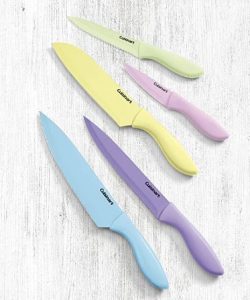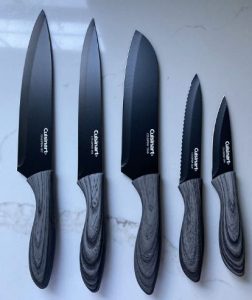Ceramic knives are prevalent kitchen tools. They can be used for a wide variety of cutting tasks, and they are often preferred by chefs over metal or wooden knives because the blades don’t rust or change shape with age. Ceramics also offer other benefits, such as being lighter in weight than steel or wood and not leaving any metallic odors on food as many traditional blade types do. The question remains though: Do ceramic knives need sharpening? And if so, how often should you sharpen them?
This article will explore the answers to those questions.
What Are Ceramic Knives?
 Ceramic knives are made of materials different from the metals used in traditional knives. The blades of ceramic knives are usually made of zirconium dioxide (ZrO2), a substance that is very hard and can hold an edge well. Ceramic knives are also lighter in weight than most traditional knives, making them easier to use.
Ceramic knives are made of materials different from the metals used in traditional knives. The blades of ceramic knives are usually made of zirconium dioxide (ZrO2), a substance that is very hard and can hold an edge well. Ceramic knives are also lighter in weight than most traditional knives, making them easier to use.
One of the main advantages of ceramic knives is that they are very resistant to corrosion. This means that they will not rust like traditional knives, and they can be used for cutting food items that contain acids, such as tomatoes. Ceramic knives are also non-reactive, meaning that they will not release any harmful chemicals or toxins into the food that is being cut.
Do Ceramic Knives Need Sharpening?
Ceramic knives are made of very hard materials, and they hold their edge a lot longer than steel knives. However, even ceramic knives need to be sharpened from time to time. The best way to sharpen a ceramic knife is with a diamond sharpener. You can buy diamond sharpeners at most hardware stores or online.
To use the diamond sharpener, first find the angle you need to sharpen the blade at. This can be done by using a protractor or by looking at the angle on the blade itself. Then, use the sharpener to hold the blade at that angle and sharpen it using gentle circular motions. Be careful not to apply too much pressure, as this can cause the blade to break.
Once the blade is sharp, you can use a honing rod to keep it that way. A honing rod is a long, thin piece of metal with a curved edge. Hold the honing rod against the blade and move it back and forth along the entire length of the blade. This will help keep the blade sharp and in good condition.
Other Ways to Sharpen Ceramic Knives
There are a few other ways to sharpen ceramic knives if you don’t have a diamond sharpener.
One way is to use an automatic (also known as electronic) ceramic knife sharpener. These can be found at most hardware stores or online. To use the sharpener, you need to turn on the electric blades. These will move automatically and are what sharpen your knife. You’ll then carefully move the knife through the thin segments where the blades are located. You should be holding the knife at a 15–20-degree angle to get the best results.
Another way to sharpen ceramic knives is by using a honing rod. A honing rod is a long, metal rod used to sharpen knives.
To use a honing rod, first angle your blade appropriately. Then put the blade against the honing rod and move it back and forth along the entire length of the honing rod. Be sure to hold the knife at the same angle while doing this. If needed, you can also use a sharpening stone to help sharpen the blade.
How Often Should You Sharpen Ceramic Knives
 Just as you would with a steel knife, you’ll want to sharpen your ceramic knives regularly. However, the duration after which you have to sharpen them depends on how often you use them and the type of cutting.
Just as you would with a steel knife, you’ll want to sharpen your ceramic knives regularly. However, the duration after which you have to sharpen them depends on how often you use them and the type of cutting.
If you only use your ceramic knives occasionally for basic slicing and chopping tasks, they may last for months without needing to be sharpened. However, if you’re doing a lot of intricate cutting or using your knife as a tool rather than just a kitchen utensil, then you’ll need to sharpen it more frequently – perhaps every few weeks.
The signs that tell you it’s time to sharpen your ceramic knife include nicks in the blade, a decrease in sharpness, and an increase in the amount of force you need to apply to the blade to make a cut.
How To Maintain Your Knives
One of the benefits of ceramic knives is that they are easier to maintain than traditional steel knives. There are a few key things you can do to keep your ceramic knives in good condition and working well.
- Always make sure that your knives are dry before putting them away. Ceramic blades can chip or break if they encounter liquid.
- Be very careful when using your knives. Ceramic blades are very sharp and can easily cut you if you’re not careful.
- Store your knives in a safe place where they can’t get damaged. You don’t want to store them in a drawer with other utensils where they could get bumped or knocked around and chipped or broken.
- Use a sharpening stone to keep your blades sharp. A dull blade is more likely to chip or break than a sharp one.
- Avoid using your knives for tasks they’re not meant for. Ceramic knives are not as durable as steel knives and can’t withstand the same amount of wear and tear. So don’t try to cut through bones or other hard objects with them.
By following these simple tips, you can help keep your ceramic knives in good condition and ensure they last for a long time.
Final Thoughts
Clearly, it’s important to keep your ceramic knives sharpened. However, you have to sharpen them correctly using the proper devices. Try a honing rod or a diamond sharpener as these are often gentle enough for use with ceramic knives. Keep an eye on the sharpness of your knives so you know when its time for to run them through the blades! We hope this helps answer the question do ceramic knives need sharpening.
